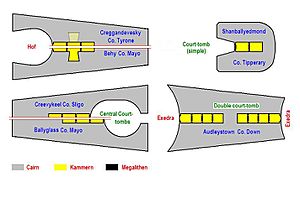Behy court tomb facts for kids
The court tomb of Behy is an ancient stone monument located in a place called Behy. This area is near Belderrig in the northern part of County Mayo, Ireland. The name Behy (Irish: An Bheithigh, meaning birch land) means "birch land" in Irish.
Archaeologists partly dug up this tomb in the 1960s. After the digging, the part they uncovered was mostly covered again by a layer of peat (a type of soil made from decayed plants).
Contents
What is a Court Tomb?
Court tombs are a special kind of ancient burial place. They are mostly found in Scotland and Ireland. There are over 400 of these tombs known in areas like Ulster, Connacht, and southwest Scotland.
These tombs get their name from an open, U-shaped area at the entrance, which looks like a courtyard. This courtyard leads into a main burial room, often made of large stones.
The Behy Tomb's Special Features
The Behy court tomb is quite unusual compared to other court tombs. Its main burial room and the area just before it are very large. This main room is shaped like a cross, which is not typical for court tombs.
Two huge flat stones, called capstones, sit on top of the main chamber. This chamber is about 2 meters (about 6.5 feet) tall. The floor inside the side rooms of the tomb is paved with stones.
Location and Surroundings
Most ancient stone tombs are found in quiet, isolated places. However, the Behy court tomb is different. It is located near an ancient settlement (a place where people used to live).
It also sits in the middle of the Céide Fields. This area is famous for having the oldest known field systems in the world. This makes the Behy tomb's location very special and unusual for a megalithic site.
How the Behy Tomb was Built
The entrance to the Behy tomb has a unique feature. It uses "drywall" material to form the slanted courtyard. Drywall means stones are stacked carefully without using mortar (cement).
Usually, court tombs use large upright stones called orthostats for their courtyards. It's possible that other court tombs also had drywall in the past. However, drywall is easier to remove than heavy orthostats, so it might have disappeared over time from other sites.
Images for kids




